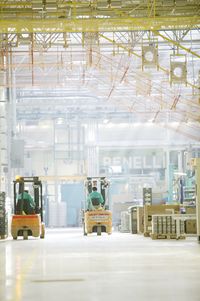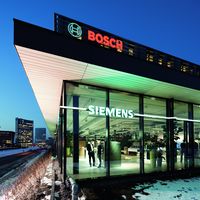Region Europe: Difference between revisions
No edit summary |
No edit summary |
||
| (One intermediate revision by the same user not shown) | |||
| Line 18: | Line 18: | ||
==== Spain and Portugal ==== | ==== Spain and Portugal ==== | ||
BSH continued to expand its presence in Europe in the 1980s, acquiring a majority share in the Spanish home appliance manufacturer Balay-Safel, resulting in a market share of 24 percent in Spain. The strong market position in Spain also increased BSH’s overall market share in Europe. As a result, at the end of the 1980s the company is the second largest manufacturer of home appliances in Europe.<ref>BSH Corporate Archives, A05-0012, inform 02/1989, p. 2f.</ref> In 1998, BSH also acquired the remaining shares in Balay, which by then also included the Safel brand, thus making the company a wholly-owned subsidiary of BSH. Balay belongs to the [[ | BSH continued to expand its presence in Europe in the 1980s, acquiring a majority share in the Spanish home appliance manufacturer Balay-Safel, resulting in a market share of 24 percent in Spain. The strong market position in Spain also increased BSH’s overall market share in Europe. As a result, at the end of the 1980s the company is the second largest manufacturer of home appliances in Europe.<ref>BSH Corporate Archives, A05-0012, inform 02/1989, p. 2f.</ref> In 1998, BSH also acquired the remaining shares in Balay, which by then also included the Safel brand, thus making the company a wholly-owned subsidiary of BSH. Balay belongs to the [[Local Heroes]] of BSH. | ||
Since 1998, BSH has marketed another brand in Spain and Portugal, UFESA, which was resold in 2018. | Since 1998, BSH has marketed another brand in Spain and Portugal, UFESA, which was resold in 2018. | ||
| Line 51: | Line 51: | ||
Construction of a new refrigeration plant and a logistics center in St. Petersburg began in 2007. The center not only sells locally produced appliances, but also BSH imports. The majority of the cooling appliances produced in St. Petersburg are destined for the Russian and Ukrainian market.<ref>BSH Corporate Archives, A05-0028, inform 2005/4, p. 8; A01-0025, Annual Report 2007, p. 7; F-BSH-001, 40 Jahre BSH – Eine Chronik, p. 122.</ref> After just three years, BSH is the market leader with Bosch in the segment of free-standing static fridge-freezer combinations. An assembly plant for washing machines was opened additionally in 2012 in St. Petersburg.<ref>BSH Corporate Archives, A01-0030, Annual Report 2012, p. 46.</ref> In 2008, BSH was able to proudly proclaim that it had a base of 3.5 million customers in Russia.<ref>BSH Corporate Archives, A05-0037, inform 2014/2, p. 11.</ref> | Construction of a new refrigeration plant and a logistics center in St. Petersburg began in 2007. The center not only sells locally produced appliances, but also BSH imports. The majority of the cooling appliances produced in St. Petersburg are destined for the Russian and Ukrainian market.<ref>BSH Corporate Archives, A05-0028, inform 2005/4, p. 8; A01-0025, Annual Report 2007, p. 7; F-BSH-001, 40 Jahre BSH – Eine Chronik, p. 122.</ref> After just three years, BSH is the market leader with Bosch in the segment of free-standing static fridge-freezer combinations. An assembly plant for washing machines was opened additionally in 2012 in St. Petersburg.<ref>BSH Corporate Archives, A01-0030, Annual Report 2012, p. 46.</ref> In 2008, BSH was able to proudly proclaim that it had a base of 3.5 million customers in Russia.<ref>BSH Corporate Archives, A05-0037, inform 2014/2, p. 11.</ref> | ||
[[file:PED(1).jpg|thumb|The Regensburg-based Electronics, Drives and Systems (EDS) has a production site in the Slovakian town of Michalovce. (Source: BSH Hausgeräte GmbH)]] | [[file:PED(1).jpg|thumb|The Regensburg-based Electronics, Drives and Systems (EDS) has a production site in the Slovakian town of Michalovce. (Source: BSH Hausgeräte GmbH)]] | ||
Latest revision as of 15:38, 15 March 2022
BSH[1] has always regarded itself not only as a German but also a European company.[2] It was founded in 1967 in the middle of the continent, in Germany. Consolidation and growth of BSH in Germany was followed by a phase of expansion into other European countries.
Most of the production locations and sales organizations today are located in Europe.[3] BSH is also the world’s leading home appliance manufacturer in Europe.[4]
Germany
After its foundation in 1967, BSH reinforced its economic position in Germany. Germany was and is BSH’s home market. It holds a strong market position here among home appliance manufacturers. BSH has several locations in Germany: Alongside the company headquarters in Munich there are production facilities in Bad Neustadt, Bretten, Dillingen, Giengen, Traunreut and Nauen. The BSH network in Deutschland also includes research and technology, and competence centers in Berlin, Bad Neustadt, Regensburg and Dillingen.
France
Gaggenau was taken over by Bosch-Siemens Hausgeräte GmbH at the end of 1994/beginning of 1995. Production and development were moved in their entirety to Lipsheim in Alsace and the company was restructured.[5]
Greece
The European expansion of BSH began with the acquisition of the Greek company Pitsos A.E. BSH acquired a majority share in the market leader for cooling appliances in Greece in 1976. Pitsos A. E. is one of the Local Heroes, the regional brands of BSH.
Spain and Portugal
BSH continued to expand its presence in Europe in the 1980s, acquiring a majority share in the Spanish home appliance manufacturer Balay-Safel, resulting in a market share of 24 percent in Spain. The strong market position in Spain also increased BSH’s overall market share in Europe. As a result, at the end of the 1980s the company is the second largest manufacturer of home appliances in Europe.[6] In 1998, BSH also acquired the remaining shares in Balay, which by then also included the Safel brand, thus making the company a wholly-owned subsidiary of BSH. Balay belongs to the Local Heroes of BSH.
Since 1998, BSH has marketed another brand in Spain and Portugal, UFESA, which was resold in 2018.
Turkey
Thanks to the excellent potential and promising growth rates of the Turkish home appliance market, the then second largest home appliance provider in Turkey became part of BSH in 1995. The established Profilo brand proved to be extremely popular with customers and is one of the Local Heroes at BSH.
Slovenia – Small appliances since 1972
Gorenje began manufacturing mixers and other small appliances for BSH in 1972 under the BSH brands in the Slovenian town of Nazarje.[7]
During the Cold War and the accompanying East-West confrontation, the multicultural state of Yugoslavia, to which Slovenia belonged, occupied a special status. Yugoslavia was one of the founding members of the organization of non-aligned states and, despite the communist state doctrine, did not count itself part of the Soviet Union-led bloc. This unique position allowed it to also work comparatively closely with companies from the West. BSH benefited from this in its cooperation with Gorenje.
After the collapse of Yugoslavia, Gorenje broke away from its home market. The plant was also destroyed by a disastrous flood at the start of the 1990s. BSH provided loans to help rebuild it. When Gorenje was unable to repay the loans, BSH took over the plant in Nazarje in 1993. Since then, small appliances have been produced there under the BSH brand names and, since 2003, also large appliances.[8]
New markets in Eastern Europe since 1989
After the fall of the Iron Curtain in 1989, BSH turned its attention to Russia and the entire Eastern European region. Since then the region has been a focal point for expansion for the company. BSH has its own sales companies in most Eastern European countries – including the Czech Republic, Serbia, Romania and Ukraine – where it benefits from the high degree of familiarity and good image of its Bosch and Siemens brands.[9]
BSH in Poland
BSH started selling Bosch home appliances in Poland in 1990. A new plant for assembling washing machines was established in the Polish city of Lodz in 1994. It was the first new plant to be built by BSH in Eastern Europe, The company thus gained a presence in the region as a producer of large appliances, allowing it to exploit its market potential to the full. The washing machines from Lodz were initially intended exclusively for the Eastern European markets, but were also extended to EU countries from 1999. The Polish BSH subsidiary was honored again with the “Pearl of the Polish Economy” award in 2009. In 2013, BSH acquired the tradition-steeped Polish home appliances manufacturer Zelmer.
BSH in Russia – from importer to manufacturer
BSH has enjoyed a presence in Russia since 1994.[10] The Bosch and Siemens brands are also very well known there and sell well. By 1995, BSH was already the largest Western European importer in Russia.[11] In 1997, the company then started looking into options for further involvement in Russia, including production partnerships.[12] It ultimately opted to develop its own production facilities. In 1998, BSH opened an assembly plant for gas cookers in Chernogolovka, 60 kilometers east of Moscow, making it the first home appliance manufacturer from the West to have a plant in Russia.[13] BSH defied the economic crisis of 1998/1999. with the Gaggenau and Neff brands being launched on the Russian market between 1998 and 2005.[14]
New production facilities
Construction of a new refrigeration plant and a logistics center in St. Petersburg began in 2007. The center not only sells locally produced appliances, but also BSH imports. The majority of the cooling appliances produced in St. Petersburg are destined for the Russian and Ukrainian market.[15] After just three years, BSH is the market leader with Bosch in the segment of free-standing static fridge-freezer combinations. An assembly plant for washing machines was opened additionally in 2012 in St. Petersburg.[16] In 2008, BSH was able to proudly proclaim that it had a base of 3.5 million customers in Russia.[17]
Slovakia – drives and controllers for BSH
The home appliance market in Slovakia is served from BSH's Czech sales company in Prague.[18]
The incorporation of the Regensburg-based Electronics, Drives and Systems (EDS) department of Siemens AG in BSH in 1998 also meant integrating the associated EDS production location for drives (engines) and electronic controllers in the Slovakian town of Michalovce.[35] At the time of the BSH takeover, there were around 930 people working at the location.[19] Since 1999, EDS has specialized completing in developing and manufacturing electronic systems for home appliances.[20] In 2009, EDS was raised to the status of a product division and renamed PED - Product Division Electronic Systems, Drives.
Sales companies in European countries
In a number of European countries sales companies, organized as BSH subsidiaries, are responsible for selling home appliances locally. These include: Denmark (Ballerup), Norway (Oslo), Sweden (Solna), Finland (Helsinki), Austria (Vienna), Belgium (Brussels), Luxembourg (Senningerberg), France (St. Oen), United Kingdom (Milton Keynes), Italy (Milan), Switzerland (Geroldswil), Czech Republic (Prague), Croatia (Zagreb), Serbia (Belgrade), Bulgaria (Sofia), Romania (Bucharest), Hungary (Budapest), Ukraine (Kiev).[21]
Netherlands
The Netherlands is home to the oldest representative offices of the parent companies of BSH, Bosch and Siemens outside of Germany. Siemens & Halske products were represented in The Hague by the company Wisse, Piccaluga & Co. as far back as 1879.[22]. The company Willem van Rijn then took over as sole representative of Bosch products in the Netherlands in 1903.[23]
The subsidiary Willem van Rijn Huishoud-elektro B.V. was founded for sales and distribution in 1986. In a move to merge the Dutch representative offices in one company, a joint venture between Willem van Rijn, BSH Huishoud-Elektro B.V. and the Consumer Products Department of Siemens Netherlands was concluded in January 2009. From this time on, the Bosch, Siemens, Gaggenau, Neff and Constructa brands were distributed by the new Dutch BSH subsidiary, BSH-Huishoudapparaten.
Notes
- ↑ BSH was founded in 1967 as Bosch-Siemens Hausgeräte GmbH - BSHG for short. In 1998, the name was changed to BSH Bosch und Siemens Hausgeräte GmbH, with the short form BSH. Since the sale of the Siemens shares in BSH to Robert Bosch GmbH the company’s name is now BSH Hausgeräte GmbH, but still BSH for short.
- ↑ „Der europäische Markt erfordert Unternehmen europäischen Ausmaßes." Quote from the preamble of the joint venture contract, BSH Corporate Archives, F-BSH-001, 40 Jahre BSH – Eine Chronik, Munich 2007, page 26.
- ↑ https://www.bsh-group.com/de/unternehmen/bsh-weltweit (Retrieved 29.08.2017)
- ↑ BSH Corporate Archives, A01-0035, Annual Report 2015, p. 2.
- ↑ Die Historie von Gaggenau (BSH Präsentation), Materialien zur Geschichte der Eisenwerke Gaggenau, BSH Corporate Archives, C03- 0296, Folie 3.
- ↑ BSH Corporate Archives, A05-0012, inform 02/1989, p. 2f.
- ↑ BSH Corporate Archives, F-BSH-001, 40 Jahre BSH – Eine Chronik, München 2007, p. 56; A01-0011, Annual Report 1993, p. 3; inform, A05-0017, 1994/3, p. 1-3.
- ↑ BSH Corporate Archives, A05-0026, inform, 2003/4, p. 18.
- ↑ BSH Corporate Archives, A01-0013, Annual Report 1995, p. 5.
- ↑ BSH Corporate Archives, A05-0037, inform 2014/2, p. 11.
- ↑ BSH Corporate Archives, A01-0013, Annual Report 1995, p. 5.
- ↑ BSH Corporate Archives, A05-0020, inform 1997/2, p. 29; A01-0015, Annual Report 1997, p. 6.
- ↑ BSH Corporate Archives, A01-0016, Annual Report 1998, p. 10.
- ↑ BSH Corporate Archives, A05-0037, inform 2014/2, p. 11.
- ↑ BSH Corporate Archives, A05-0028, inform 2005/4, p. 8; A01-0025, Annual Report 2007, p. 7; F-BSH-001, 40 Jahre BSH – Eine Chronik, p. 122.
- ↑ BSH Corporate Archives, A01-0030, Annual Report 2012, p. 46.
- ↑ BSH Corporate Archives, A05-0037, inform 2014/2, p. 11.
- ↑ BSH Corporate Archives, A05-0020, inform 1997/4, p. 19; A05-0025, inform 2002/3, p. 4.
- ↑ BSH Corporate Archives, A01-0018, Geschäftsbericht 2000, p. 25.
- ↑ BSH Corporate Archives, A05-0022, inform, 1999/3, p. 20 f. Corporate Archives, A05-0036, inform 2013/5, p. 3.
- ↑ https://www.bsh-group.com/company/bsh-worldwide (Retrieved 30.08.2017)
- ↑ Siemens History: Siemens in the Netherlands.
- ↑ BSH Corporate Archives, Tochtermann Historie, Ordner 5, 100 Jahre Bosch – Willem van Rijn, Amsterdam 2003, p. 1.




